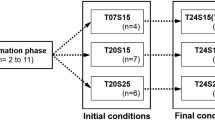Abstract
Patterns of sexual size dimorphism and body size in calanoid copepods are examined. We hypothesize that favorable conditions for development will result in large body size and high sexual size dimorphism among populations of a given species and that differences in this allometric relationship among species is governed by the male's role in insemination. We confirm that there is a greater advantage to large female size, normally the larger sex, when compared to males, hence leading to selection for developmental patterns favoring high size dimorphism. Individuals from populations of four centropagid copepod species were measured; other sizes were obtained from published sources. In the four species we examined, the relationships between prosome length and both clutch size and the ability to produce multiple clutches with one insemination were determined. Results show a trend toward hyperallometry in all centropagid species examined: sexual size dimorphism increases with increasing size. Large females produce larger clutches and more additional clutches on one insemination. That hyperallometry is not observed in diaptomid copepods may result from the greater role the male plays in reproduction. Males are needed for each clutch produced, hence the selective pressure to be larger is greater than that in the centropagidae.
Similar content being viewed by others
References
Cheverud, J. M., M. M. Dow & W. Leutenegger, 1985. The qualitative assessment of phylogenetic constraints in comparative analyses of sexual size dimorphism in body weight among primates. Evolution 39: 1335-1351.
Chow-Fraser, P. & E. J. Maly, 1992. Size divergence and dietary partitioning enhance coexistence of two herbivorous species of Diaptomus (Copepoda: Calanoida) in some shallow Quebec lakes. Can. J. Zool. 70: 1018-1028.
Corkett, C. J.& I. A. McLaren, 1969. Egg production and oil storage by the copepod Pseudocalanus in the laboratory. J. exp. Mar. Biol. Ecol. 3: 90-105.
DeFrenza J., R. J. Kirner, E. J. Maly & H. C. van Leeuwen, 1986. The relationshps of sex size ratio and season to mating intensity in some calanoid copepods. Limnol. Oceanogr. 31: 491-496.
Escribano, R. & I. A. McLaren, 1992. Testing hypothess of exponential growth and size-dependent molting rate in two copepod species. Mar. Biol. 114: 31-39.
Fairbairn, D. J. 1990. Factors influencing sexual size dimorphism in temperate water striders. Am. Nat. 136: 61-86.
Fairbairn, D. J., 1997. Allometry for sexual size dimorphism: pattern and process in the coevolution of body size in males and females. Ann. Rev. Ecol. Syst. 28: 659-687.
Fairbairn, D. J. & R. F. Preziosi, 1994. Sexual selection and the evolution of allometry in the water strider Aquarius remigis. Am. Nat. 144: 101-118.
Fairbridge, W. S., 1945. West Australian freshwater calanoids (Copepoda) I. Three new species of Boeckella, with a description of the developmental stages of B. opaqua n. sp., and a key to the genus. J. roy. Soc. West. Aust. 29: 25-65.
Gilbert, J. J. & C. E. Williamson, 1983. Sexual size dimorphism in zooplankton (Copepoda, Cladocera, and Rotifers). Ann. Rev. Ecol. Syst. 14: 1-33.
Grad, G. & E. J. Maly, 1992. Further observations relating sex size ratios to mating success in calanoid copepods. J. Plankton Res. 14: 903-913.
Hall, D. J., S. T. Threlkeld, C. W. Burns & P. H. Crowley, 1976. The size efficiency hypothesis and the size structure of zooplankton communities. Ann. Rev. Ecol. Syst. 7: 177-208.
Jamieson, C. & C. W. Burns, 1988. The effects of temperature and food on copepodite development, growth and reproduction in three species of Boeckella (Copepoda: Calanoida). Hydrobiologia 164: 235-257.
Kobayashi, T., 1993. Resource partitioning of Calamoecia lucas Brady and Boeckella triarticulata (Thompson) (Copepoda: Calanoida) in an Australian reservoir. Hydrobiologia 254: 35-42.
Kobayashi, T., 1995. Different patterns of resource use between two coexisting freshwater calanoid species. Aust. J. mar. Freshwat. Res. 46: 481-484.
Landry, M. R., 1983. The development of marine copepods with comment on the isochronal rule. Limnol. Oceanogr. 28: 614-624.
Lock, A. R. & I. A. McLaren, 1970. The effect of varying and constant temperatures on the size of a marine copepod. Limnol. Oceanogr. 15: 638-640.
Maier, G., 1995. Mating frequency and interspecific mating in some freshwater cyclopoid copepods. Oecologia 101: 245-250.
Maly, E. J., 1973. Density, size, and clutch of two high altitude diaptomid copepods. Limnol. Oceanogr. 18: 840-848.
Maly, E. J., 1978. Some factors influencing size of Diaptomus shoshone. Limnol. Oceanogr. 23: 835-837.
Maly, E. J., 1983. Some further observations on diaptomid body size and clutch size relationships. Limnol. Oceanogr. 28: 148-152.
Maly, E. J., 1984a. Dispersal ability and relative avbundance of Boeckella and Calamoecia (Copepoda: Calanoida) in Australian and New Zealand waters. Oecologia 62: 173-181.
Maly, E. J., 1984b. Factors influencing distribution and body size of several Quebec calanoid copepods. Crustaceana Suppl. 7: 25-35.
Maly, E. J., 1991. Mating and multiple clutches in Australian Boeckella and Calamoecia (Copepoda: Calanoida). Can. J. Fish. aquat. Sci. 48: 1077-1080.
Miller, C. B. & J. K. Johnson, 1977. Growth rules in the marine copepod genus Acartia. Limnol. Oceanogr. 22: 326-335.
Nishikawa, T. S. & E. J. Maly, 1996. Factors influencing the degree of sexual size dimorphism within and among calanoid copepod species. Oecologia 107: 490-497.
Reiss, M. J., 1989. The allometry of growth and reproduction. Cambridge University Press, Cambridge. 182 pp.
Rensch, B., 1959. Evolution above the species level. Methuen, London. 419 pp.
Smyly, W. J. P., 1968. Number of eggs and body size in the freshwater copepod Diaptomus gracilis Sars in the English Lake District. Oikos 19: 323-338.
Sokal, R. R. & F. J. Rohlf, 1995. Biometry. W. H. Freeman & Co., San Francisco. 858 pp.
Svenssen, J-E., 1997. Fish predation on Eudiaptomus gracilis in relation to clutch size, body size, and sex: a field experiment. Hydrobiologia 344: 155-161.
Watras, C. J. & J. F. Haney, 1980. Oscillations in the reproductive condition of Diaptomus leptopus (Copepoda: Calanoida) and their relation to rates of egg-clutch production. Oecologia 45: 94-103.
Author information
Authors and Affiliations
Rights and permissions
About this article
Cite this article
Maly, E.J., Maly, M.P. Body size and sexual size dimorphism in calanoid copepods. Hydrobiologia 391, 171–177 (1998). https://doi.org/10.1023/A:1003597614322
Issue Date:
DOI: https://doi.org/10.1023/A:1003597614322




